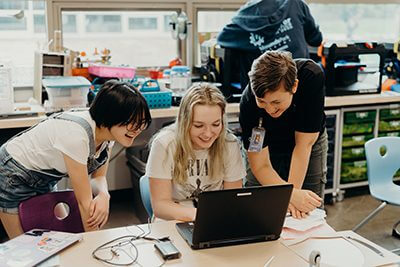August 29, 2019
 Schools are busy places. Filled with energy, excitement, and activity, the dynamic ecosystem of a school creates a natural space for interaction among students, faculty, and families. But simply being together in the same place, at the same time, doesn’t automatically foster an environment where students feel interconnected, welcomed, and known. Creating community is an active, deliberate process. It’s a core accountability for academic institutions, and an essential element of MPA’s DNA—it’s built into who were are and what we do, with a support system that fuels academic success and facilitates a lifetime of wellbeing for students.
Schools are busy places. Filled with energy, excitement, and activity, the dynamic ecosystem of a school creates a natural space for interaction among students, faculty, and families. But simply being together in the same place, at the same time, doesn’t automatically foster an environment where students feel interconnected, welcomed, and known. Creating community is an active, deliberate process. It’s a core accountability for academic institutions, and an essential element of MPA’s DNA—it’s built into who were are and what we do, with a support system that fuels academic success and facilitates a lifetime of wellbeing for students.
“As a parent and a member of the administrative team, I can speak to my own personal experience about the impact of MPA’s community,” shares Jennifer Rogers-Petitt, director of development and community engagement. “I started in my role, and my children started as MPA students, in mid-October of last year. It was definitely a big change, with my then second and seventh grader having already begun the academic year at other schools. But from the start, what they experienced in their classrooms, with their peers and from their teachers helped them feel they could make this transition, and my children never looked back. As a mom, that meant everything and put my mind at ease. And as development director, it’s so inspiring to see how in this community everyone chips in—not just through philanthropy, but also in the time and talents they share with our school.”
Parent Leah Anderson also sees community as an essential part of the MPA fabric. “MPA wraps a supportive, welcoming, positive community around all of it to make asking big questions and sharing ideas safe and possible,” Anderson says. “It’s a killer mash-up that means we have a kid who jumps out of bed in the morning excited to go to school and nearly always enthusiastically answers ‘great!’ when asked ‘how was your day?’ Really, what more could parents ask for?”
Community Strength, Academic Motivation
Eric Schaps, founder of the Developmental Studies Center, writes how those feelings of belonging tie directly to academic performance and personal development, “which makes the creation of caring, inclusive, participatory communities for our students especially important.” Schaps explains that “a growing body of research confirms the benefits of building a sense of community in school. Students in schools with a strong sense of community are more likely to be academically motivated (Solomon, Battistich, Watson, Schaps, & Lewis, 2000); to act ethically and altruistically (Schaps, Battistich, & Solomon, 1997); to develop social and emotional competencies (Solomon et al., 2000); and to avoid a number of problem behaviors, including drug use and violence (Resnick et al., 1997).”
Schaps sees four specific approaches as key levers in building community and maximizing the value students and families receive from a healthy school environment:
- actively cultivate respectful, supportive relationships among students, teachers, and parents;
- emphasize common purposes and ideals;
- provide regular opportunities for service and cooperation; and
- provide developmentally appropriate opportunities for autonomy and influence.
MPA embraces those principles, helping students chart a journey and find a place where they can learn, live, and thrive together. Students develop meaningful, collaborative relationships across grade levels, and are as proud of their own accomplishments as they are of their classmates’ achievements. Parent feedback reflects that same view—in a survey earlier this year about MPA’s strengths, the top response was “welcoming, kind, caring, inclusive, and safe community,” followed by “excellent faculty who really know students well.”
A Community Of Volunteerism
Along with MPA’s faculty, dedicated volunteers generously enrich the community through their daily contributions. During the last school year, nearly 300 volunteers donated more than 6,100 hours of their time in support of MPA. Nearly 70 percent of current parents are volunteers, with the remaining 30 percent including grandparents, alumni, parents of alumni, friends and other supporters, demonstrating that the MPA community extends far beyond the physical borders of school. MPA volunteers tackle projects of all sizes, from hosting the spring auction and decorating the school for commencement, to reading in the classroom, teaching a skill in the Makerspace, or leading a tour for a prospective family.
Those school strengths, and school relationships, continue to resonate after graduation. “One of the best parts about my job is meeting alumni and parents of alumni, and listening to what they share about their teachers, their clubs, their sports, their academics,” says Rogers. “When I hear those stories, I think about the stories my children will be able to tell, how teachers and parents know each other on a first name basis, what it means to have so many people joining together to support students. It’s all so crucial to the classroom experience, and MPA wouldn’t be what it is without that level of family involvement.”
Learn more about it: Strong Community, Strong Education
This policy brief from the National Education Association outlines the positive impact of parent, family, and community involvement in education.
“What makes independent schools special,” from the National Association of Independent Schools, underscores inclusiveness and community as strengths that schools like MPA can provide.
Advice from Scholastic on volunteering in the classroom.